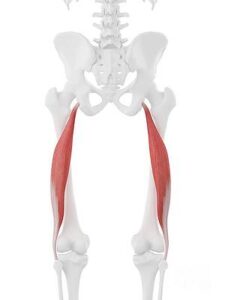While hamstring strains are common injuries in athletes, you can do things to reduce your risk of suffering from a hamstring injury.
What are the hamstrings?
The hamstrings are a group of three muscles at the back of the thigh. These muscles help you bend your knee and extend your hip. They are “two-joint” muscles meaning they cross two joints and influence movement at both.
The hamstrings are attached to the ‘sit bone’ of the pelvis and cross the back of the knee joint to attach to the bones of the lower leg:

- Semitendinosus – attaches to the back of the shin bone (tibia) on the inside of the back of the knee.

- Semimembranous – also attaches to the back of the shin bone (tibia) on the inside of the back of the knee.

- Biceps femoris – attaches to the top of the smaller bone of the lower leg (fibula) on the outside of the back of the knee.


What is a hamstring strain?
A hamstring strain is a tear to one or more of the three large muscles at the back of the thigh.
There are three grades of hamstring injury are:
- Grade I: a mild muscle strain – likely to recover in a few days.
- Grade II: a partial muscle tear.
- Grade III: a complete muscle tear or tear of an attachment – may take weeks or months to heal.

What causes hamstring injuries?
Hamstring injuries are common in sports that involve short bursts of sprinting, suddenly stops and changes direction, and jumping. This type of injury is commonly seen in football, baseball, tennis, and running track.
Hamstring injuries most often occur at the end of the swing phase of running, just before the outstretched leg hits the ground. At this point of the gait cycle, the hamstring muscles have to suddenly shorten (contract) to bend the knee.
What makes a hamstring injury more likely?
There are several factors that may contribute to a hamstring injury more likely:
- Muscle strength – weak hamstrings or a muscle imbalance between the hamstrings and the quadriceps.
- Warming up – improper or inadequate warm-up prior to activity.
- Fatigue – poor form/mechanics due to fatigue.
- Core stability – Lack of core stability results in compensation and altered mechanics.
- Flexibility/Mobility – Lack of muscle flexibility or joint mobility contributes to poor mechanics and possible overloading of the hamstring.
- Poor running technique – Lack of hip flexion or overloading the hamstring.
Each of these factors are modifiable, meaning that you can correct these deficiencies and reduce your risk of a hamstring strain.
How Can Physical Therapy Help You?
Our team of specialists can help you mitigate your risk of a hamstring strain while participating in the activities you love. Your physical therapist will assess your strength, mobility, flexibility and biomechanics to determine factors that may contribute to risk of a hamstring injury. They will work with you to design a program specifically for you to keep you healthy and active.
In the event you are suffering a recent or chronic hamstring strain, your therapist will perform hands on treatment and prescribe exercises to facilitate healing and get you back to your activities.
Reach out to schedule an appointment with one of our Physical Therapist today!

